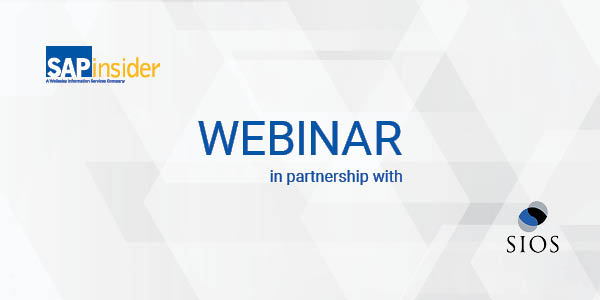When building up complex stack of software and hardware needed to support enterprise IT, businesses spend a lot of time and effort establishing resilient and efficient systems that support their unique operational needs. Among the thousands of decisions they need to make is the choice of platform for
SAP applications. While most organizations choose the traditional Linux option, some lean toward a Windows environment.
There are several potential reasons for this decision—cost, compatibility, preference—but no matter why a company chooses Windows, it will still need to maintain high availability (HA) for its mission-critical applications.
The Crossroads of Cost and Compatibility
As with many decisions, choosing whether to deploy SAP applications on Windows or a more traditional Linux environment is a matter of balance. It is important to consider the high availability (HA) options as part of this decision-making process. Every company's reasoning will likely be unique to its own circumstances, but most of them come down to two key factors - cost and compatibility.
For example, one of the most common motivations behind choosing a Windows environment is that the business is already familiar with and deeply integrated into the Windows ecosystem. In this case, the bulk of their IT team skill set and software stack are built around Windows environments and an understanding of Windows HA.
Compatibility extends beyond mere interoperability between different software applications, however, it encompasses the entire ecosystem within which these applications operate. Organizations with a longstanding reliance on Windows sometimes find it easier to adopt the same environment for their SAP applications from an organizational as well as a technical perspective. Sticking with a familiar framework simplifies management, reduces complexity, and can lead to improved system stability and performance. Beyond this, for organizations already deeply integrated into Windows, deploying its SAP database in that environment can offer a more cost-effective solution, thanks partly to licensing advantages and the ability to integrate with existing infrastructure. Again, this has an organizational impact, as it can allow businesses to leverage existing investments in Windows-based systems without the need for additional expenditure on new platforms or extensive retraining of IT staff.
Challenges and Solutions
Deploying SAP on Windows is not without its hurdles. It can sometimes present a unique blend of technical and administrative challenges that test the experience of even the largest organizations' IT teams.
The most obvious source of complexity is the fact that SAP databases are built on Linux, even if the application layer operates within a Windows environment. Even if an enterprise is committed to Windows, it will still have to deal with Linux sooner or later if it wants to use an SAP database. This dual-sided nature means IT teams must take a nuanced approach to system management & HA and harmonize operations across different platforms.
Ensuring seamless integration between the SAP application layer and the underlying Windows infrastructure calls for meticulous network and system parameters configuration. The goal is to optimize performance and reliability, ensuring that the SAP applications run smoothly and efficiently on the Windows platform. The need for robust monitoring and HA protection practices further compounds this complex task. IT teams must implement systems that proactively identify potential issues and automate routine tasks, thereby maintaining system health and preventing unplanned downtime.
In the quest for high availability, a range of solutions have emerged, explicitly tailored to the needs of SAP applications – specifically SAP Central Services – operating within Windows environments. The Windows Server Failover Clustering (WSFC) feature is central to many of these solutions, which is the foundation of Microsoft's high-availability offerings. WSFC provides a framework for creating redundant system configurations, enabling services to continue running even in the event of hardware or software failures. This feature allows organizations to ensure their critical SAP databases remain accessible even during failure, minimizing downtime and the associated business impacts.
However, WSFC is just one piece of the puzzle. Various third-party tools and services are also available, designed to simplify and extend the HA capabilities inherent to the Windows platform. These tools, such as SIOS DataKeeper, complement WSFC while reducing cost and complexity by eliminating the need for shared storage. SIOS HA clustering software provides additional layers of protection, enhances the resilience of SAP deployments against downtime and disasters.
Removing the Single Point of Failure
As in any IT environment, a key factor in implementing HA for SAP applications in a Windows environment is effectively identifying and addressing single points of failure. This task demands a comprehensive review of the SAP deployment's entire architecture—from the tangible hardware components to the intricate software configurations that underpin the system's operations. Potential vulnerabilities are not limited to any single aspect of the system; they can range from network bottlenecks, which impede data flow and reduce system responsiveness, to insufficient storage redundancy, which increases the risk of data loss. Ironically, this can also include the use of shared storage as part of the HA configuration.
In response to these challenges, modern HA solutions designed for Windows environments have evolved to incorporate sophisticated technologies that prioritize redundancy, enhance failover capabilities, and ensure robust data replication. These solutions build on the principle that no single component's failure should jeopardize the entire system's availability.
By implementing redundancy at various levels of the IT infrastructure, organizations can create a resilient framework where alternative resources automatically take over in the event of a failure, thereby minimizing downtime. Data replication plays a crucial role in this architecture, with technologies enabling synchronous or asynchronous data copying across the system. This capability maintains data integrity, even in the face of hardware failures or software issues, by keeping copies of critical data in separate, secure locations.
A Strategic Approach
Adopting modern HA solutions tailored to the unique requirements of SAP deployments in Windows environments is essential for organizations aiming to safeguard the continuous availability of their critical applications.
This strategic approach supports seamless business operations and secures a competitive advantage in today's fast-paced market environment. However, as technology advances, the landscape of HA solutions will also evolve, presenting new opportunities and challenges. IT professionals must remain vigilant and adaptable, continually updating their knowledge and strategies to leverage the latest innovations in HA technology. By doing so, they can ensure that their enterprise systems - no matter their environment- are resilient, reliable, and aligned with the best practices in system design and management for high availability.








